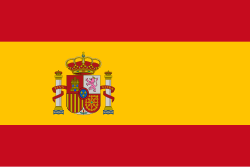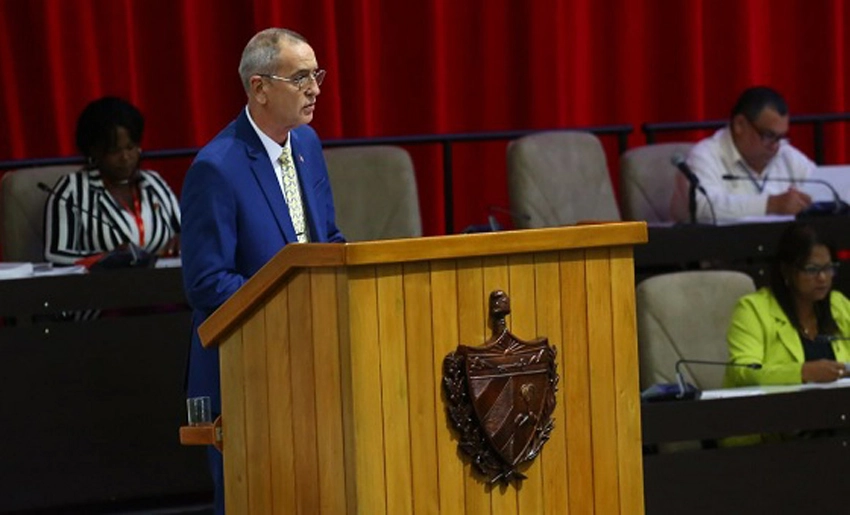Since 2021, the Cuban economy has been under the challenges of the transformations of the Ordering Task. The negative effects of the COVID-19 pandemic, and the irrational, inhumane, and genocidal economic war waged by the United States government. The Minister of Economy and Planning, Joaquín Alonso Vázquez, stated before the deputies this Wednesday.
In offering the report on the economy in 2024 and the first half of 2025, the minister noted that these variables. Along with the global economic crisis, burden and make it difficult to fulfill plans, projections, and strategies.
He said that errors, deviations, and negative trends also affect the conduct of the economy, both at the macro and microeconomic levels. As well as the economic, commercial, and financial blockade of the United States, which has intensified in recent years.
All these factors, the Minister of Economy and Planning continued, generate and sustain over time “internal imbalances that manifest themselves in inflationary pressures. A fragmented foreign exchange market, and critical restrictions on the availability of foreign currency, fuel, and electricity, hampering industrial and productive activity and essential services.”
In 2024, the gross domestic product (GDP) registered a decrease at constant prices of 1.1%, slightly lower than that recorded in 2023, but maintaining the trend of economic contraction. At the same time, GDP by type of economic activity reflects an asymmetrical behavior, with positive results in some sectors and types of activity.
Moreover with the decline in agriculture and manufacturing, primary and secondary activities showed a drop of 17.9% and 3%.
Within tertiary activity (-0.1%), non-social services grew by 0.9% (primarily due to tourism and communications). Helping to reduce the negative impact on social services, which decreased by 2% (primarily in education).
Exports and Foreign Exchange Income
Alonso Vázquez reported that at the end of the first half of the year, foreign currency earnings from exports were 91% fulfilled. A figure 7% lower than that achieved in the same period in 2024.
Meanwhile, foreign currency earnings from the financial system are expected to be 90% fulfilled as planned, although important exportable products such as tobacco, lobster, and fish products, including eel, have recovered during the period.
These increases, the minister stated, “were not sufficient to offset the decline in nickel and other mining products, honey, coal, farmed and sea shrimp, and biopharmaceutical products. Primarily affected by the physical quantities produced due to the shortage of inputs, energy, and fuel, as well as the decline in some international market prices and logistical problems.”
This situation led to the fulfillment of the goods export plan during the period at 62%. A result lower than that achieved in the same period in 2024 (78%). In terms of services exports, telecommunications services over-fulfilled the half-year plan by 3.5%. Although they still decreased by 19% compared to the same period in 2024.
In medical services, there was a slight over-fulfillment of the planned export plan, “although it should be noted that the business model in Cuba has been experiencing difficulties with medical supplies and consumables. Futhermore which affects international sales, low-priced programs requested, and a decrease in medical care for tourists, in line with conventional tourism levels.”
At the close of the first half of 2025, tourism services are experiencing significant impacts on their execution. Influenced by the low levels of visitor arrivals to the country (1,000,600 visitors, 71% of the plan and 77% compared to the same period in 2024).
Among the causes, the minister mentioned the cancellation of airline operations, smear campaigns against Cuba as a destination, and difficulties associated with supplies, which affect the quality and stability of services.
In the first half of 2025, exports of non-state-owned enterprises reached $21 million, 30% more than in the same period in 2024.
The report specifies that more than 85% of exports correspond to merchandise, with charcoal being the most exported product. The remainder consists of service exports, with computer application development and support services being the most representative.
Imports of Goods and Services
Data for the first half of 2025 indicate that imports of goods and services are 67% fulfilled and 7% exceed execution.
“Food, fuel, medicines, and medical supplies were prioritized,” said the Minister of Economy and Planning, specifying that when comparing commercial imports by product group with respect to 2024. “There is evidence of a decrease in the volume of food, which continues to be the largest item, and an increase in machinery and equipment.”
During the first half of the year, imports from non-state-owned enterprises exceeded $1 billion, 34% more than in the same period in 2024.
This is primarily influenced by MSMEs (70%), followed by private enterprises (26%), and, to a lesser extent, artisans, agricultural, and non-agricultural cooperatives (4%).
Among the main imported products are raw materials and intermediate products (37%), food (22%), beverages (16%), and machinery, appliances, and their parts (13%).
In terms of foreign direct investment (FDI), 14 new businesses with foreign capital were approved during the first half of the year. Related to wholesale and retail marketing, hydrocarbon exploitation and production, mineral processing and marketing, light industry, and financial activities.
Agricultural and Sugar Production
The report presented by the Minister of Economy and Planning indicates that rice, vegetables, and root vegetables are among the agricultural products that, at the end of the first half of the year, are meeting the plan and exceeding production levels compared to the same period in 2024.
“The production figures achieved do not meet the population’s demands and are insufficient to cover the deficit in imported food. Furthermore, they are far from existing production capacity,” stated Alonso Vázquez.
He noted that ensuring the entirety of products currently imported for the regulated family basket is economically unsustainable for the country, and that there are productive capacities that can be leveraged to fill this gap.
“Progress in this regard will depend on the management of each municipality and province. As part of the process of decentralizing powers and compliance with the Law on Food Sovereignty and Food and Nutritional Security,” he stated.
He further stated that at the close of the first half of the year, the sugar harvest remains in noncompliance, with raw sugar production levels below 44% of what was expected, insufficient to guarantee restricted consumption.
The situation is mainly influenced by the insufficient availability of sugarcane. Physical fuel for cutting, harvesting, and pulling the sugarcane; and noncompliance with the harvesting process.
In addition, delays in sugarcane planting persist, with only 50% of the planned harvest completed to date. “If this situation continues, it will not be possible to achieve significant increases in the 2026 and 2027 harvests due to the low availability of raw materials. So sugar production will remain at levels similar to those achieved this year,” the minister warned.
He explained that to reverse this situation, progress is being made in developing new businesses with foreign investment and establishing internal linkages with the main consumers of raw materials and byproducts of sugar production, such as molasses and alcohols.
Recovery of the National Energy System (SEN) is Strategic; Renewable Energy Sources (RES) Account for 6.4 Percent of the Energy Matrix
According to the report presented by the Minister of Economy and Planning, progress was made in the first half of the year in recovering electricity generation capacity with investments in renewable energy sources (RES), the recovery of 575 MW of generating capacity through the repair of fuel oil and diesel engines, and restoration work at thermoelectric plants.
The participation of REs in the Cuban energy matrix currently stands at 6.4%. Twenty-two planned photovoltaic solar parks have been synchronized, contributing 481 MW to the SEN, and the investment program is progressing as planned.
Alonso Vázquez noted that electricity generation is lower than planned and lower than what was achieved at the same time in 2024.
He indicated that oil equivalent production for the period is around the target, with quantities slightly higher than what was achieved at the same time in 2024. A technological and logistical recovery has been achieved that will allow this trend to be maintained.
“Crude oil production is over-supplied, a trend that will continue in the second half of the year, but gas production continues to be under-supplied due to well disruptions that generate production instability,” he stated.
According to the minister, gas production is recovering in July, and an increase in production is estimated for the fourth quarter of the year, driven by deals with foreign partners and the arrival of parts for recovery.
He specified that the main impacts are concentrated in LPG, diesel, and fuel oil, the latter two having a corresponding negative impact on electricity generation and the economy.
Some Progress in the First Half of the Year
- Progress was made on prioritized programs and investments, most notably those related to food production.
- The installation of 12 irrigation systems was completed to benefit the grain, mixed-crop, and coffee program.
- A rice dryer with a capacity of 9,620 tons was put into operation.
- 17 hectares of aquaculture ponds were completed and put into operation.
- 20 dairy farms were rehabilitated, five of them for the rehabilitation of 2,000 head of cattle. The rest were carried out through actions aimed at infrastructure and livestock genetics.
- 22 photovoltaic solar parks were completed. 967 solar modules were installed in homes. Generation capacity was restored as a result of the repair of 75 fuel oil and diesel engines and restoration work on four thermoelectric plant blocks.
- Work was done to restore out-of-order rooms, ending the semester with 225 rooms restored.
- The fuel tank capital repair program has recovered 2,475 cubic meters of storage space in six tanks.
- 7.9 kilometers of hydraulic network rehabilitation were completed. 100 kilometers of water supply networks and pipelines and 12.3 kilometers of sewage pipelines were completed, benefiting more than 700,000 people. 63 pumping units were installed, responding to the energy matrix change program and improving water service to 68,698 residents without the need for backup power.
- In the railway sector, capital repairs were completed on 104 pieces of equipment (including 93 rail cars and one locomotive).
- Anti-inflationary measures currently underway allowed prices to continue to slow, but they continue to rise in the first half of the year.
- Since March 2023, when year-on-year inflation reached 46.4%, the deceleration of this indicator has been maintained. At the end of June 2025, the rate registered a 14.75% year-on-year index, maintaining its downward trend, well below the projected target (around 30%).
- During this period, the universe of economic actors has grown and now consists of 19,428 entities: 2,843 state-owned entities, 110 joint ventures and wholly foreign-owned companies, 5,106 cooperatives, and 11,369 MSMEs.
- Since the process began, 11,745 new economic actors have been approved, of which 11,369 are private MSMEs, 305 are state-owned MSMEs, and 71 are non-agricultural cooperatives. The most representative activities are services and commerce, although a significant number maintain manufacturing and food production as their core activities. With information from Cubadebate
- CTC in Holguin Analyzes Personnel Policy and Unionization - 12 de December de 2025
- Cuban Foreign Ministry Declares Intensified Economic War Against Cuba - 12 de December de 2025
- Havana Film Festival Awards Ceremony - 12 de December de 2025

